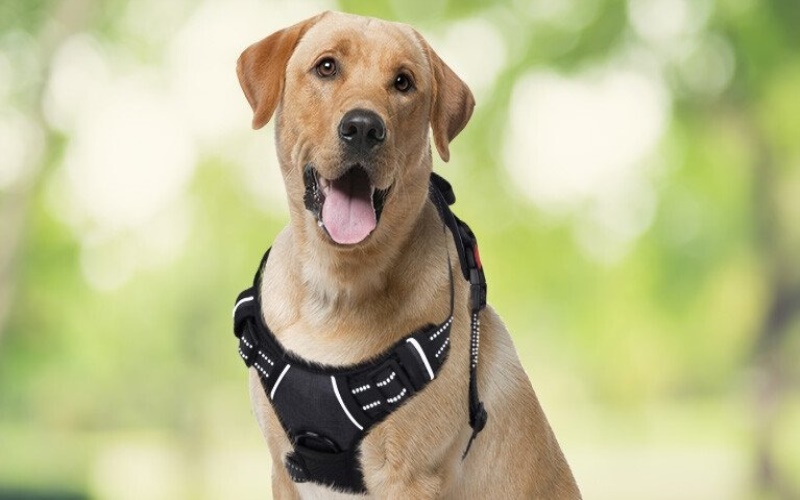Walking a dog should be an enjoyable and stress-free experience for both the owner and the furry friend. However, for many dog owners, the reality is quite different, especially if their canine companion tends to pull incessantly during walks. This common issue has led to the development of various tools, and one such solution gaining popularity is the no-pull dog harness. In this article, we will delve into the science behind a no-pull dog harness and explore how it works to provide a more comfortable and controlled walking experience.
A No Pull Dog Harness
Now let us understand how does a no-pull dog harness works. A no-pull dog harness is designed to discourage pulling during walks. It typically features a front attachment point, redirecting the dog’s attention to the side when they pull. This design minimizes strain on the neck and provides better control for the owner, promoting a more enjoyable and stress-free walking experience.
Understanding the Problem:
Before delving into the intricacies of no-pull harnesses, it’s crucial to understand why some dogs exhibit pulling behavior during walks. Dogs, being naturally curious and energetic animals, may be motivated by a variety of factors, including excitement, a desire to explore, or a reaction to stimuli such as other animals or scents. Traditional collars and leashes can exacerbate pulling issues, as they may cause discomfort or even injury to the dog’s neck, leading to negative associations with walking and potentially reinforcing pulling behavior.
No-pull harnesses aim to address these issues by distributing the force across the dog’s body rather than concentrating it on the neck. To grasp the science behind these harnesses, let’s break down their key features and functions.
Front Attachment Design:
Most no-pull harnesses feature a front attachment point, typically located on the dog’s chest. This design redirects the force created by the dog’s pulling to the front of their body, naturally encouraging them to turn back toward the owner. This redirection helps to curb pulling without causing discomfort or harm to the dog.
From a biomechanical perspective, the front attachment exploits the dog’s instinct to move in the path of least resistance. When a dog pulls against the front attachment, the harness guides their body to face the owner, reinforcing the desired walking behavior.
Pressure Distribution:
The design of no-pull harnesses is centered around the idea of distributing pressure evenly across the dog’s body. Unlike traditional collars that focus the force on the neck, potentially causing discomfort and injury, these harnesses spread the pressure over the chest, shoulders, and sometimes the back.
By dispersing the force, no-pull harnesses minimize the likelihood of causing harm to the dog’s sensitive neck area. This is particularly important for breeds prone to respiratory issues or those with delicate neck structures.
Comfortable Fit and Padding:
The science behind a no-pull dog harness also involves the emphasis on a comfortable and secure fit. The harnesses are designed to snugly fit around the dog’s body without restricting movement. Many high-quality no-pull harnesses include padded areas, which not only enhance comfort but also reduce the risk of chafing or irritation.
A comfortable fit is essential for ensuring that the dog is willing to wear the harness without resistance. If a harness is uncomfortable, the dog may resist putting it on or exhibit anxious behavior during walks, defeating the purpose of using such a tool.
Positive Reinforcement:
Beyond the mechanical aspects, the psychology of no-pull harnesses plays a crucial role in their effectiveness. These harnesses are often paired with positive reinforcement techniques, such as treats or verbal praise, to encourage desired behavior.
When a dog walks without pulling, the owner can reward them, reinforcing the association between proper leash behavior and positive experiences. This positive reinforcement contributes to the overall success of the no-pull harness as a training tool. Therapy dog training often includes teaching them to walk calmly on a leash, making no-pull harnesses a valuable aid in preparing them for their role in providing comfort and support to those in need.
Training and Adaptation:
While the science behind no-pull harnesses provides a solid foundation for their effectiveness, it’s essential to recognize that these tools work best when used in conjunction with proper training techniques. Introducing a no-pull harness to a dog requires patience, consistency, and positive reinforcement.
Dogs may initially resist wearing a harness or exhibit confusion about the change in walking dynamics. Dog training sessions with the harness should be gradual, allowing the dog to adapt to the new sensations and associations. Consistent use of positive reinforcement during walks helps solidify the connection between appropriate behavior and rewards, facilitating a smoother transition.
Conclusion:
The science behind how a no-pull dog harness works revolves around understanding canine behavior, biomechanics, and the importance of positive reinforcement. By redistributing pressure away from the neck, these harnesses offer a humane and effective solution to curb pulling behavior during walks. The front attachment design, pressure distribution, comfortable fit, and positive reinforcement techniques collectively contribute to the success of no-pull harnesses in providing a more enjoyable and controlled walking experience for both dogs and their owners. Training a therapy dog involves specialized techniques to ensure they can provide comfort, support, and companionship to individuals in need, highlighting the profound impact dogs can have in therapeutic settings.

